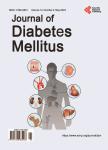Diabetes and Hypertension in a Santhal Tribe in Bangladesh: A Population Based Study
Diabetes and Hypertension in a Santhal Tribe in Bangladesh: A Population Based Study作者机构:Department of Community Medicine Ibrahim Medical College Dhaka Bangladesh Department of Epidemiology BIRDEM Dhaka Bangladesh Institute of Nutrition and Food Science University of Dhaka Dhaka Bangladesh
出 版 物:《Journal of Diabetes Mellitus》 (糖尿病(英文))
年 卷 期:2014年第4卷第2期
页 面:133-140页
学科分类:1002[医学-临床医学] 100201[医学-内科学(含:心血管病、血液病、呼吸系病、消化系病、内分泌与代谢病、肾病、风湿病、传染病)] 10[医学]
主 题:Santhal Obesity Diabetes Hypertension Lipids
摘 要:BACKGROUND: Santhal (Santals) tribe is one of the oldest and largest aboriginal pre Aryan populations in India and Bangladesh. There was no published report on the prevalence of diabetes and hypertension. OBJECTIVE: To determine the prevalence of type 2 diabetes mellitus (T2DM) and hypertension in a Santhal tribe of Bangladesh. RESEARCH DESIGN AND METHODS: Eight villages inhabited largely by Santhal tribe were purposively selected. All Santhals aged 20 years or more were considered eligible and enlisted for the study. Investigations included socio-demographic information (age, sex, education, income), clinical history (general illness), anthropometry (height, weight, waist-girth, hip-girth) and blood pressure. Body mass index (BMI) and waist-to-hip ration (WHR) were calculated. Blood samples were collected for fasting plasma glucose (FPG), total cholesterol (Chol), triglycerides (TG), urea and creatinine. RESULTS: Thirteen hundred eligible Santhals were enlisted. Of them, 1049 (80.7%) participated in the study. The male and female participants were 40% and 60%, respectively. The prevalence of T2DM was 0.6% and hyperglycemia (FPG 5.5 mmol/l) was 10.0%. The prevalence of systolic hypertension (sHTN) was 24.4% and diastolic hypertension (dHTN) was 24.6%. Compared with the males the females had significantly higher prevalence of sHTN (OR, 2.20 with 95% CI, 1.62 - 3.02) and dHTN (OR, 1.81 with CI, 1.34 - 2.0);whereas, the prevalence of T2DM and IFG did not differ. Regarding obesity 45% of the participants had BMI 23.1. Logistic regression estimated that the increasing age, female sex, higher FPG (5.5 mmol/l) and higher Chol (160 mg/dl) had independent risk for sHTN and dHTN. CONCLUSIONS: The Santhals had less risk for diabetes but increased risk for hypertension. The Santhal females had excess risk of hypertension. Advancing age, female sex, hyperglycemia and hypercholesterolemia were found to have significant risk for hypertension. Obesity had no effect on diabetes



